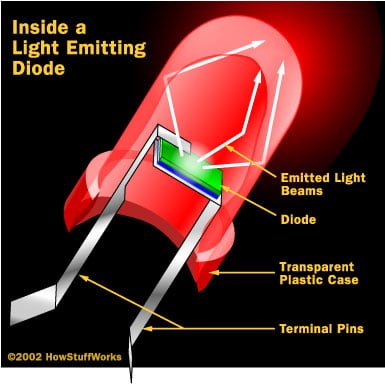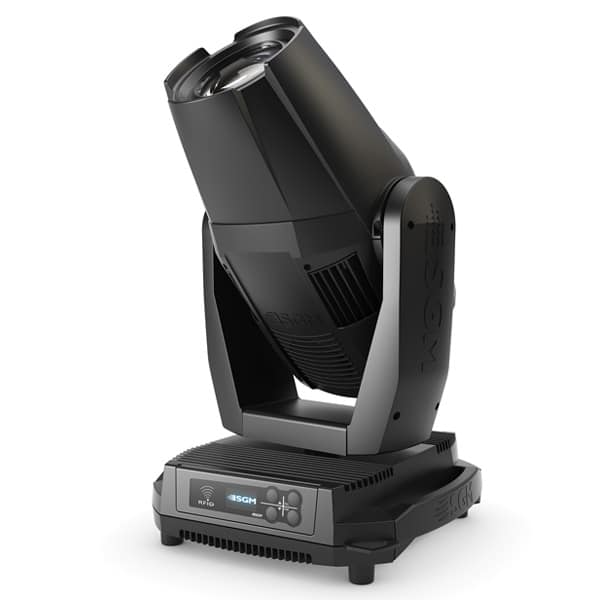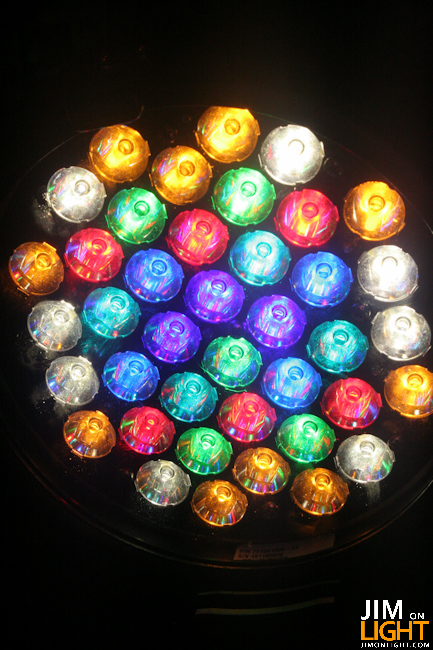

20 facts on LEDs?! Jim, are you CRAZY? I just might be! Let’s call it Friday Facts!
Happy Friday everyone — I am going absolutely LED nuts around here lately, as I’ve replaced most of the incandescent lamps in our house with their LED A-lamp equivalents. Surprisingly enough, I haven’t lost my hair, found the need to eat bugs, or lost any sleep because of screwed-up circadian rhythms, as some claim are side-effects of LED A-lamps. Oh, that burns me brighter than an Alpha 18K in Dallas in the summer!
Friday Facts time! 20 Really Awesome Facts about LEDs, or Light-Emitting Diodes!
- When LED light is used in delicatessen displays and in places with fresh food, it has been proven to breed significantly less bacteria than their halogen or fluorescent counterparts. Consider that next time you’re getting stuff for sandwiches! I would say that significantly NO bacteria is the right amount for my sandwiches!
- Remember the name Nick Holonyak, Jr. – he is the father of the visible light LED. Nick invented the LED while working for General Electric in 1962. This “new thing” that’s come onto the retail market over the last 5 years has been around since the mid-1960s!
- Next time you see a blue LED, think of Shuji Nakamura, the inventor of the blue LED, back in 1994. Nakamura, who was working for Nichia Corporation at the time, got a $200 bonus for his discovery – while Nichia made more money than is in Scrooge McDuck’s swimming pool! Nakamura never signed a non-disclosure for Nichia, and in 2001 he sued for $189 million. The Japanese courts awarded him more money than any other Japanese company ever had to pay in court: $8.1 million. So the inventor of the blue LED got $8,100,200 for his invention that we all use everywhere!
- Most blue and green LEDs use a mixture of Gallium Nitride and Indium Nitride to get the blue, called Indium Gallium Nitride (InGaN). By varying the amount of Indium in the mix, the color of blue varies.
- Most red, orange, and yellow LEDs use variants of Gallium Phosphide (GaP) Gallium Arsenide Phosphide (GaAsP) to get their hues.
- White LEDs work quite like fluorescent lamps work with respect to color; a blue or ultraviolet LED is coated with a phosphor that emits photons from the ultraviolet frequencies when the LED is energized.
- The Monsanto Corporation was the first company to mass-produce red LEDs for the industry, mostly as replacement lights for indicators and seven-segment displays.
- An incandescent lamp converts about 9-10% of the energy fed to it into light, whereas LEDs convert at least 50% of that incoming energy they consume as light, the rest being lost to heat generation.
- The lighting industries as a whole are pushing LEDs to replace incandescent sources in a variety of applications, but the first time that LEDs actually did displace incandescent lamps was in vehicle brake lights, signal lights, and traffic lights – back in 1987!
- If the entire United States would replace only 50% of the existing incandescent Christmas lights around the holidays, the potential energy cost savings starts around $17.2 billion dollars.
- Heat generated by an LED source is a real enemy to the quality of that LED source. LEDs are subject to the cooling method designed into the lamp or fixture — if the cooling is good, the LED will maintain a decent output over its lamp life. If the cooling is poor, the lamp is subject to considerably higher lumen depreciation over its lifetime, or even total failure over time.
- If you’ve ever had a porch, you’ve had a porch light, and you’ve had bugs all over that porch light. Switch to LED in the porch light and you’ll notice considerably fewer bugs, if not a complete decrease in your porch bug population! Why, do you ask? It’s because incandescent lamps and CFLs produce copious amounts of ultraviolet (UV) and infrared (IR) radiation, which bugs love more than Kim Kardashian loves mascara!
- LED headlights might be one of the most annoying, blinding things on the road, but they’re actually quite safe for driving – LED headlights render colors you see in their beams better, which gives you better awareness of your surroundings on the road. They’re totally worth it!
- Due to the physics involved, LED lamps have what we call Instant On — unlike their incandescent and compact fluorescent (CFL) counterparts. What this means is that you can switch an LED lamp on and you get the full brightness of that light instantly. Think about this next time you need to place a lamp in a part of your house or office that gets turned on and off frequently — incandescent lamps and CFLs experience significantly less lamp life from being switched on and off frequently, and CFLs in particular can experience greatly reduced lamp life if they are switched off and back on within 15 minutes of heating up!
- Most LED A-lamp replacement bulbs are relatively cool to the touch, whereas their incandescent and halogen counterparts will most definitely leave you with a first or second degree burn. Maximum operating temperature for most residential A-lamp type bulbs is around 135-140 degrees Fahrenheit, where halogen lamps run around 600-700 F to the touch and their incandescent cousins run around 375-400 F to the touch! OUCH!
- If you think about incandescent lamp life (around 1000 hours) and compact fluorescent lamp life (around 10,000 hours), It’s not hard to see how LEDs are making the grade in retail markets. A majority of residential/commercial LED A-lamp manufacturers claim a whopping 50,000 hours lamp life on average, with newer models claiming up to 100,000 hours. If this sounds impressive, it is! Consider your usage on just the 50,000 hour varieties:
If you use your LED bulb for 24 hours a day, every day, that bulb is rated to last 6 solid years!
If you use your LED bulb for 8 hours a day, every day, that bulb is rated to last 17 years!!
If you use your LED bulb for only 4 hours per day, that bulb is rated to last 17 years!!! - LEDs contain NO MERCURY at all — and over 95% of an LED is recyclable. Compare this to the wasteful design of compact fluorescent lamps (CFLs), which not only contain Mercury, but also create a large portion of electronic waste due to their design — the fluorescent tube portion of a CFL ceases to work long before the ballast inside the CFL or its other electronic components are ready to die. This alone creates tons of waste every month.
- LED lamps on average are not subject to serious damage from external shock – which translates into “oops, I dropped my LED lamp onto the floor while I was changing it!” If you try this with an incandescent lamp, you’re going to be cleaning up glass at least — and if it’s a CFL, not only will it break, but you will also need to follow Mercury decontamination procedures recommended by the Environmental Protection Agency. Yikes!
- The U.S. Department of Energy estimates that the widespread adoption of LEDs in residential and commercial applications over the next 20 years will save about $265 billion, prevent the need for constructing 40 new power plants, and reduce the electricity demand of lighting by 33 percent.
- Ever wonder why non-chip form LEDs have that little plastic bubble (or lens) around them, like in the picture at the top of the post? It actually has three distinct functions, and the process of adding the diode to the plastic is called potting:
* The plastic protects the tiny wires and components that make up the diode from physical damage, and protects the diode from open air
* The plastic makes mounting the LED inside of devices and equipment considerably easier
* That plastic lens allows the light from the LED to have a variety of properties, like different beam angles and diffusions





